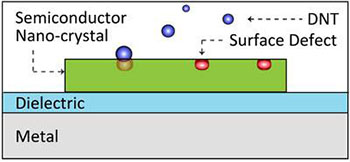
The plasmon laser sensor consists of a 50-nm-thick semiconductor separated from the metal surface by an 8-nm-thick dielectric gap layer. (Credit: Ren-Min Ma and Sadao Ota)
In the race to develop ever-more-sensitive detectors for explosives, and thereby stay ahead of increasingly sophisticated modern terrorist groups, a team of U.S. researchers has developed a new tool in the arsenal: an active plasmon laser sensor that can detect certain chemicals used in bomb-making at concentrations far lower than those published to date for other optical sensors (Nat. Nanotech., DOI: 10.1038/nnano.2014.135).
Plasmonic sensors, which couple electromagnetic radiation with subwavelength plasmons on a metal surface, already enable high-sensitivity, real-time detection in a variety of applications. But designs until now have been based on passively excited surface plasmons, in which the signal’s energy quickly dissipates, limiting the device sensitivity. To get around that conundrum, scientists at the University of California, Berkeley, and Lawrence Berkeley National Laboratory, U.S.A., deployed a more active approach, under which the surface plasmon sensor simultaneously acts as a nanoscale sensing medium and as a laser gain medium to boost the signal.
The plasmon laser sensor consists of a 50-nm-thick, 600-nm-long CdS semiconductor slab, separated from a silver substrate by an 8-nm-thick dielectric. Airborne molecular traces of explosive compounds, which tend to be electron-deficient, interact with the semiconductor surface, stimulating emission in the lasing plasmon nanocavity. The increase in light intensity allows the sensor signal to be read, at sub-parts-per-billion concentrations for some compounds—a level far more sensitive, according to the team, than the best optical sensors currently reported.
The difference in intensity between the signals of conventional passive plasmon sensors and the new device is “similar to going from a light bulb for a table lamp to a laser pointer,” said senior author Xiang Zhang. “We create a sharper signal which makes it easier to detect even smaller changes for tiny traces of explosives in the air.” The team hopes that that enhanced sensitivity will enable it to detect agents such as pentaerythritol tetranitrate (PETN), a notoriously difficult to detect explosive that has emerged as a favorite of terrorist groups.
